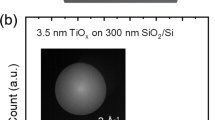Abstract
This paper discusses the evolution in the degradation and breakdown behaviour of ultra-thin oxides when scaling the oxide thickness into the sub-4 nm range for future CMOS technology generations. It will be shown that changes in the breakdown statistics, which can be explained by a percolation model for breakdown, lead to an increased area dependence of the time-to-breakdown. This has to be taken into account when predicting the oxide reliability. Also the impact of the test methodology, the relevance of a so-called polarity gap in the charge-to-breakdown and its consequences for reliability testing, are highlighted. Moreover, a strong increase in the temperature dependence of breakdown, especially for sub-3 nm oxides, is demonstrated and the impact of temperature on trap generation and critical trap density at breakdown is discussed. Finally it is shown that the combined effects of all these phenomena might lead to oxide reliability becoming a potential showstopper for further technology scaling.
Similar content being viewed by others
References
R. Degraeve, G. Groeseneken, R. Bellens, J.L. Ogier, M. Depas, Ph. Roussel, H.E. Maes, IEEE Trans. Elec. Dev., vol. 45, No. 4, pp. 904–911, 1998.
T. Nigam, R. Degraeve, G. Groeseneken, M. Heyns and H.E. Maes, Proc. Intern. Rel. Phys. Symp. (IRPS), p. 62, 1998
E. Wu, E. Nowak, J. Aitken, W. Abadeer, L.K. Han, S. Lo, IEDM Tech. Dig., p. 187, 1998.
D.R. Wolters, J.F. Verwey, Instabilities in silicon devices, Chapter 6, Elsevier Science Publishers B.V., 1986.
K. F. Schuegraf, C. Hu, J. Appl. Phys., vol. 76, no. 6, pp. 3695–3700, 1994.
D.J. DiMaria, E. Cartier, D. Arnold, J. Appl. Phys., vol. 73, no. 7, pp. 3367, 1993.
D. J. DiMaria, J. Appl. Phys., vol. 81, no.7, p3220, 1997.
T. Nigam, M. Depas, R. Degraeve, M.M. Heyns, G. Groeseneken, Extended abstracts SSDM, pp. 90–91, 1997.
N. Pangon, R. Degraeve, P. J. Roussel, G. Groeseneken and H. E. Maes, “A new physically-based model for temperature acceleration of time-to-breakdown,” presented at 1998 SISC.
D. J. DiMaria and J. H. Stathis, Appl. Phys. Lett. vol 74, p. 1752, 1999.
B. Kaczer, R. Degraeve, N. Pangon, T. Nigam, and G. Groeseneken, Microelectronics Engineering, vol. 48, p. 47–50, 1999
R. Degraeve, N. Pangon, B. Kaczer, T. Nigam, G. Groeseneken, and A. Naem, “Temperature acceleration of oxide breakdown and its impact on ultra-thin gate oxide reliability,” VLSI Technology Symposium, Kyoto, Japan, 1999.
B. De Salvo, G. Ghibaudo, G. Pananakakis, B. Guillaumot, P. Candelier, 1998 ESSDERC Proc., p. 228, 1998.
B. Kaczer, R. Degraeve, N. Pangon, T. Nigam, and G. Groeseneken, Proceedings ESSDERC 1999, p. 356, Editions Frontieres, Leuven, Belgium, 1999.
B. Kaczer, R. Degraeve, N. Pangon, and G. Groeseneken, “Non-equivalence of temperatureaccelerated electrical stress of thin silicon dioxide films,” submitted to Appl. Phys. Lett., 1999
SIA, “National technology roadmap for semiconductors,” 1997 Edition, 1997.
J. H. Stathis and D. J. DiMaria, 1998 IEDM Tech. Dig., p. 167, 1998.
Acknowledgments
The authors would like to acknowledge the contributions to and discussions about this work of the following people: Philippe Roussel (IMEC), Nadège Pangon, Jan De Blauwe (now at Lucent Technologies), Tanya Nigam (now at Lucent Technologies), Geert Van den bosch (IMEC), Marc Schaekers (IMEC), Jean-Luc Ogier (now at ST Microelectronics), Felice Crupi (now at University of Pisa), Isodiana Crupi (now at University of Messina) and Marc Heyns (IMEC)
We would also like to acknowledge the financial support from National Semiconductor Corp., Alcatel Telecom, the Flemish Institute for Science and Technology (1WT) and the European project ESPRIT 24115 (Advanced CMOS for Europe).
Author information
Authors and Affiliations
Corresponding author
Rights and permissions
About this article
Cite this article
Groeseneken, G., Degraeve, R., Kaczer, B. et al. Impact of temperature and breakdown statistics on reliability predictions for ultra-thin oxides. MRS Online Proceedings Library 592, 295–306 (1999). https://doi.org/10.1557/PROC-592-295
Published:
Issue Date:
DOI: https://doi.org/10.1557/PROC-592-295




